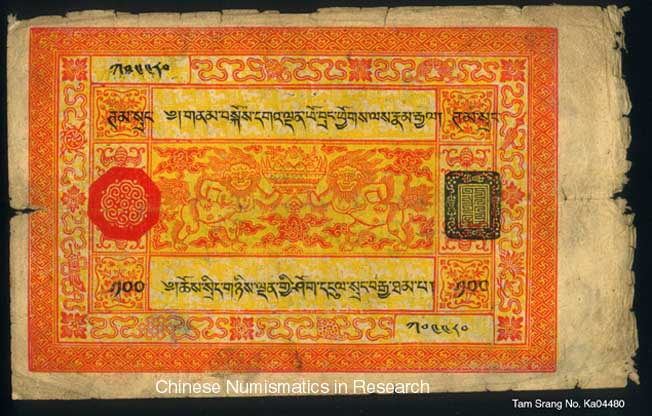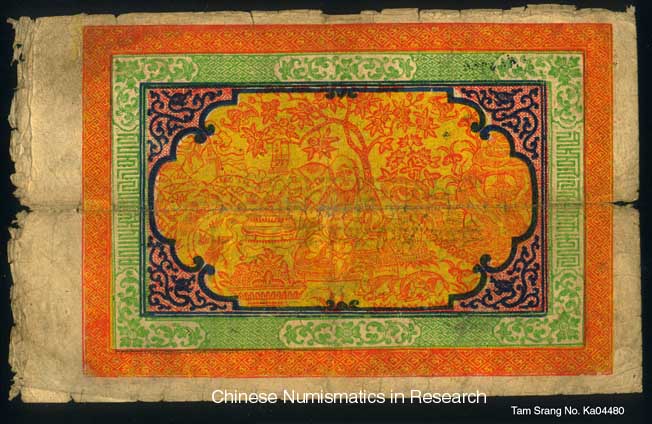The use of money in China could be traced back to at least four
thousand years ago. China was also the first country to use paper
money, or credit currency in the world. Due to the difficult of language and communication, it is not an easy thing for me to study the numismatic history of Tibit. Tibit as a part of Chinese family of nationality, but paper money was only introduced into this minority nationality area in the early 20th century. I posted below is a Tibet 100 Tam Srang Note. This note is believed to be printed in 1937 and it was printed by Cha-Hsi Motor Plant  or Cha-Hsi Le-K'ung Mint [The Lhasa Mint of the Tibet Local Government], and or known as the Trabshi Lekhung by Western. or Cha-Hsi Le-K'ung Mint [The Lhasa Mint of the Tibet Local Government], and or known as the Trabshi Lekhung by Western.
Note: According to the books of "A Study of Tibetan Paper Money with a Critical Bibliography" by Mr. Wolfgang Berisch. Only 50,000 notes with the denomination in "Tam Srang" (with the red octogonal seal which was usually used on the earlier issues of Tam notes) were issued. After 50,000 notes of 100 Tam Srang had been issued, the denomination was changed to "srang". A different red seal and some changes in the design of the obverse of thenotes were introduced. |
Paper Money issued by
Tibetan Regional Government

 , meaning the "Tibetan government is all victorious anywhere", is printed horizontally across the top centre of the second inner frame in black. The row of Tibetan words
, meaning the "Tibetan government is all victorious anywhere", is printed horizontally across the top centre of the second inner frame in black. The row of Tibetan words , meaning the "Government and Religion in one and the paper money valued at 100 Srang" printed horizontally across the bottom centre of the second inner frame in black. Two lions are holding with a fruit bowl is printed at the centre of the note between two geometrical seals, Dalai Lama's red octogonal seal and Cha-Hsi Le-K'ung Mint black rectangular seal. [Please be noted that the later issued 100 srang notes, the red octogonal seal would be changed with a small red circular seal. The underprint with four rats pattern also would be changed later.]
, meaning the "Government and Religion in one and the paper money valued at 100 Srang" printed horizontally across the bottom centre of the second inner frame in black. Two lions are holding with a fruit bowl is printed at the centre of the note between two geometrical seals, Dalai Lama's red octogonal seal and Cha-Hsi Le-K'ung Mint black rectangular seal. [Please be noted that the later issued 100 srang notes, the red octogonal seal would be changed with a small red circular seal. The underprint with four rats pattern also would be changed later.]

 , located at northern outskirts of Lhasa, and was established in 1932, as a part of the Cha-Hsi Mint. All the products of the Kam-Tung Paper Factory served the Cha-Hsi Mint only. The materials using to make paper containing with the root of a kind of poisonous weed
, located at northern outskirts of Lhasa, and was established in 1932, as a part of the Cha-Hsi Mint. All the products of the Kam-Tung Paper Factory served the Cha-Hsi Mint only. The materials using to make paper containing with the root of a kind of poisonous weed  in order to prevent the spoiling by the insects and the rats. The paper was soft and tough with plain surface. [counterfeit note existed with vertical texture on the surface] Each month, the factory produced 5000 boxes of paper only, and 500 to 1000 pieces per each box.
in order to prevent the spoiling by the insects and the rats. The paper was soft and tough with plain surface. [counterfeit note existed with vertical texture on the surface] Each month, the factory produced 5000 boxes of paper only, and 500 to 1000 pieces per each box.  :
:  1987 p.17, 51, 55, 60. (The History of Tibetan Money).
1987 p.17, 51, 55, 60. (The History of Tibetan Money).